We may earn revenue from the products available on this page and participate in affiliate programs. Learn more ›
_
Best Overall
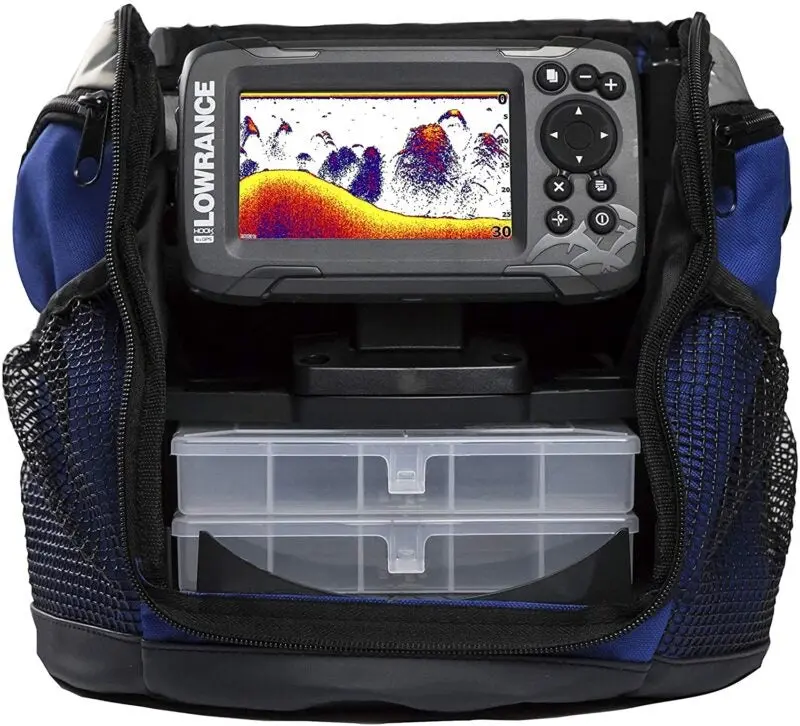
Lowrance Hook2 4X
Best Fish Finder GPS Combo
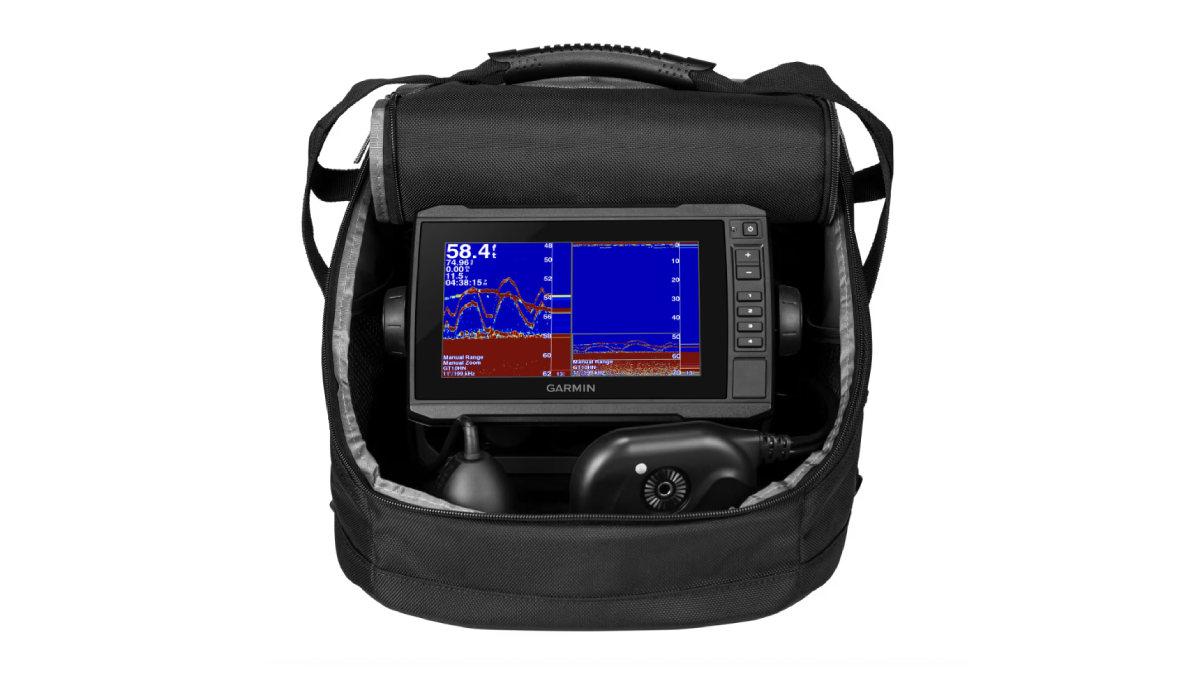
Garmin Echomap UHD 7 Panoptix PS22 Bundle
Best Budget
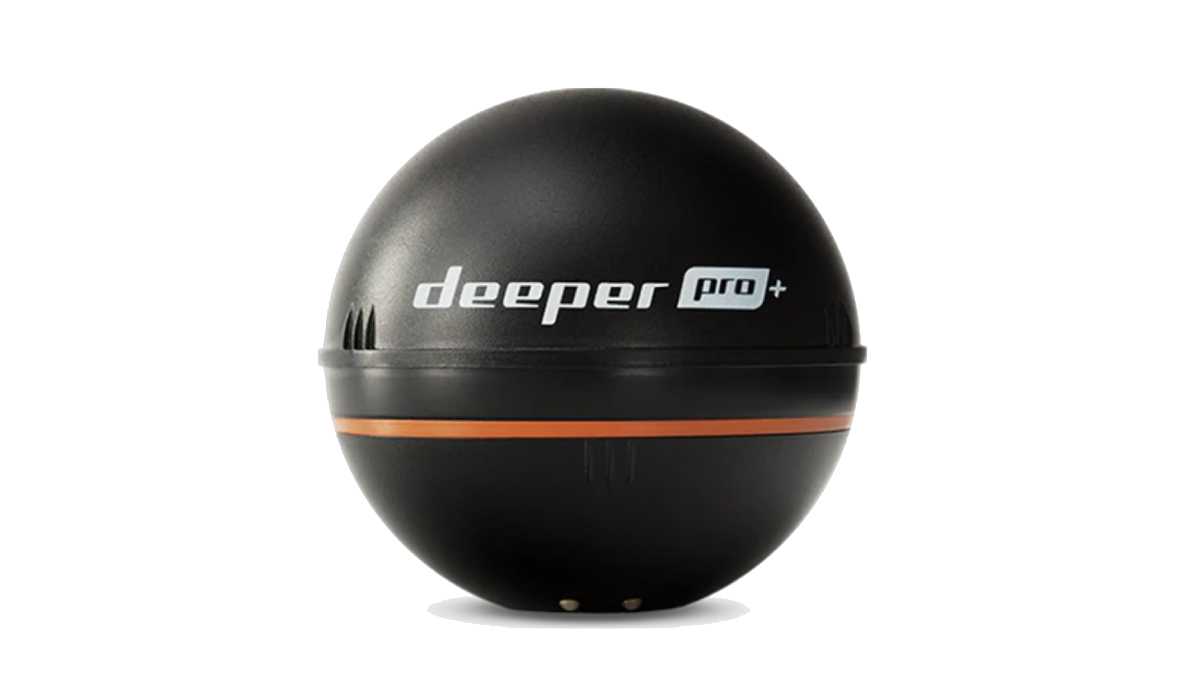
Deeper Pro Plus
Whether fishing out of your kayak after work, on the boat for the weekend, or on the ice in winter, a portable fish finder will come in handy. The movable device will help you determine structure, depth, water temperature, and, of course, find fish. And just because you might fish five different ways doesn’t mean you need five different units. A good one will be adaptable and powerful enough to cover the water wherever you fish.
Traditional fish finders are permanently mounted on a boat with a transducer on the bottom of the hull. But modern models from the likes of Garmin, Lowrance, and Humminbird have revolutionized the game, allowing anglers to take their device wherever they fish whether it be from a boat, kayak, through the ice, or from shore. To help you find the perfect fit for your fishing style, I tested out some of the best portable fish finders available, including some with side imaging and GPS and some that are even castable.
The Best Portable Fish Finders
Best Portable Fish Finder Overall: Lowrance Hook2 4X
Best Fish Finder GPS Combo: Garmin Echomap UHD 7 Panoptix PS22 Bundle
Best Humminbird: Humminbird Helix 5 CHIRP GPS G3 PT
Best for Kayak: HawkEye Fishtrax 1C-K Paddlesport
Best For Bank Fishing: Lucky Handheld Fish Finder
Best for Ice Fishing: Humminbird Ice Helix 9 Mega Live
Best Budget: Deeper Pro Plus
Best Portable Fish Finder Overall: Lowrance Hook2 4X
Best Overall

Lowrance Hook2 4X Lowrance
Pros
More affordable than other fish finders we tested
User-friendly
Compact
Vivid imaging
Cons
Battery not included
Balancing a color display, dual-beam sonar, basic navigation, compact size, and low cost, the Lowrance Hook2 4x is the best portable fish finder for the widest range of users and also one of the best Lowrance fish finders. The wide-angle transducer produces bright, detailed images of structure and fish.
On the navigation side, the Hook2 4x has a GPS plotter to mark waypoints, set a course, and track progress. This versatile portable Lowrance fish finder and GPS is housed in a sturdy carry case with room for tackle trays and a battery. Best of all, this Lowrance fish finder is available at a great price, and they have solid models at varying price points.
Specs
Weight: 4.5 pounds
Dimensions: 18” x 10” x 6”
Screen Size: 4 inches
Best Fish Finder GPS Combo: Garmin Echomap UHD 7 Panoptix PS22 Bundle
Best Fish Finder GPS Combo

Pros
Live view sonar
Premium charts
Touchscreen
Cons
Heavy lead acid battery
Combining the best live view sonar and navigation charts in a convenient carry case, the Garmin Echomap UHD 7 Panoptix PS22 offers top-of-the line performance, making it one of the best Garmin fish finders. The seven-inch touchscreen display is easy to operate and the right size to take anywhere. CHIRP sonar sends signals on two frequencies to produce a detailed image of fish and structure. Switch to LiveVu Forward or LiveVu Down to get a real-time, video-like live image of fish up to 100 feet away.
To find the most productive water, the Echomap 7 UHD is preloaded with Garmin’s premium LakeVu charts and Navionics navigation data. Bluetooth and Wi-Fi connectivity allow you to access navigation data and update charts with a smartphone.
Garmin’s most advanced fish finder and GPS also comes in a convenient carry case that holds transducers, battery, and display. The bundle includes a swivel pole to position the LiveVu transducer under the ice and a traditional transducer for CHIRP sonar. The Garmin UHD 7 Panoptix bundle allows you to take one of the most powerful fish finders anywhere you wet a line.
Note: If you want to dip your toe into Garmin’s offering before shelling out $1,900 for the Echomap, consider the entry-level Garmin Striker 4 (more on that below).
Specs
Weight: 16.7 pounds
Dimensions: 12.3” x 14.5” x 10”
Screen Size: 7 inches
Best Humminbird: Humminbird Helix 5 CHIRP GPS G3 PT
Best Humminbird
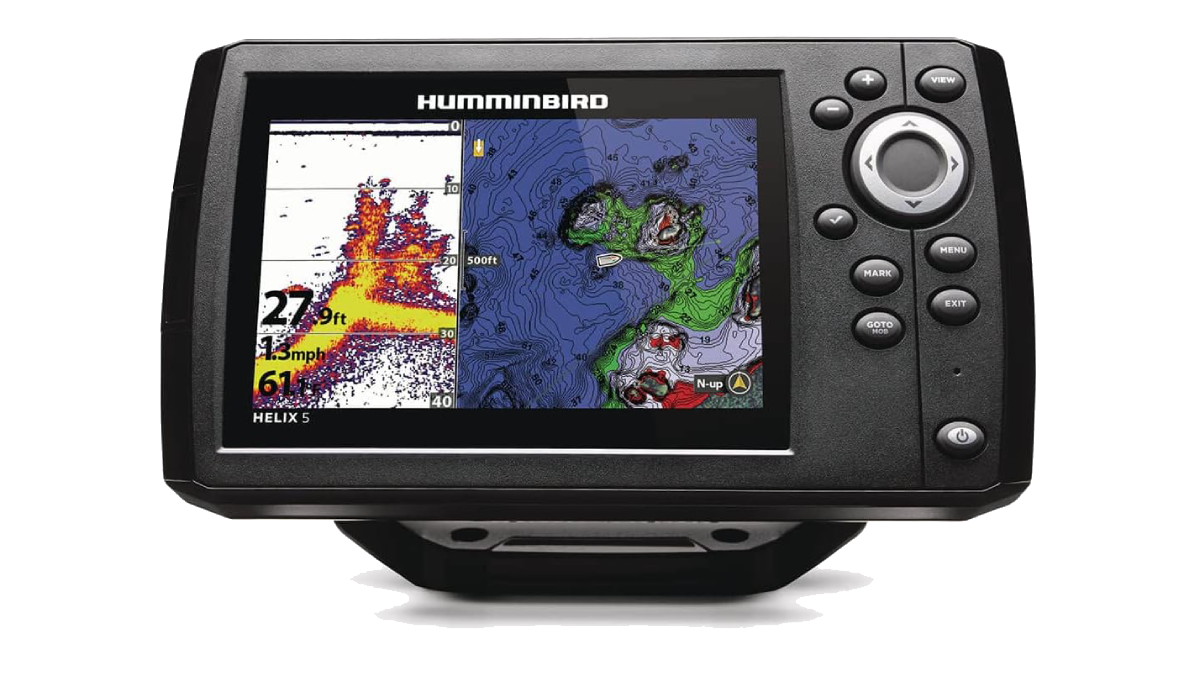
Pros
Great value in accessories
Auto-chart capability
Touchscreen
Cons
Not compatible with more advanced transducers
Humminbird fish finders always offer excellent value, and the Helix 5 dual spectrum CHIRP setup is no exception. It’s set up for ice fishing out of the box, complete with battery. However, this unit will easily transition to a Jon boat or kayak with almost no modifications necessary. The Helix 5 comes with a Humminbird base map included. But it can also be upgraded with the company’s SD card updates.
One unsung feature of Humminbird’s Helix units is the auto-chart capability. For anglers who go fishing on smaller, lesser-known lakes without charts, it’s a game changer. Simply turn the feature on and the unit will map the lake’s bottom as you explore it. It’s a solid option for anglers who only fish a few lakes and don’t need an expensive card full of lakes they’ll never visit.
I also just like the consistency in Humminbird’s buttons and navigation. While I’m used to the Helix 9, the menus and settings are nearly identical in the Helix 5. It’s very easy to set up and tweak the settings on the water based on the conditions.
The only real downside to this unit is that it’s not compatible with Humminbird’s more detailed imaging systems like side, down, 360, or Mega Live Imaging. However, the 2D CHIRP sonar is more than capable for most fishing scenarios. The fact that Humminbird sells this combo for under $500 with a battery and a carrying case included just sweetens the deal. We like this unit for anglers who are just getting started in electronics and want versatility. The Helix 5 is a sophisticated and reliable system that’s not going to totally break the bank.
Specs
Weight: 12.5 pounds
Dimensions: 755” x 4.28” x 1.13”
Screen Size: 5 inches
Best Garmin: Garmin Striker 4 Portable Bundle
Best Garmin

Pros
Highly affordable
Good for ice fishing and boats
Doubles as a flasher unit
Cons
Doesn’t show lake elevations
When it comes to low profile units that are light and portable, the Garmin Striker 4 is a standout. This is a unit that easily transitions between an ice unit and a kayak unit because it is lightweight and uses up little space. Using a rail accessory, it will fit nearly any fishing kayak. The narrow screen also helps it stay balanced better on the rail than a wide screen. This unit has a simple CHIRP transducer that produces some nice, crisp images. It’s more a personal preference thing, but I like the crispness of the Garmin’s CHIRP display. Mainly because it’s a little easier to separate fish targets from other junk that might be showing in the water column.
While this unit has GPS, it’s only there for marking fish and interesting underwater structure encountered along the way. This unit does not have underwater contours. It’s not a deal breaker, but it could mean a little extra searching on the angler’s part to identify the best spots. We’re fine with that because the unit does have a nice built-in flasher unit for the traditionalists. It’s meant for ice fishing, but there’s nothing that says you can’t use it for vertical fishing from a boat.
The Striker 4 is also frequently on sale, meaning it’s easy to snag one for under the regular $200 price tag. We also just like the fact that the transducer can easily be upgraded to Garmin’s GT8 or GT15 for a little extra sensitivity. This is a unit that can grow with the angler a little while just getting started with electronics.
Read our full review of the Garmin Striker 4.
Specs
Weight: 10.8 pounds
Dimensions: 3.6” x 5.9” x 1.6”
Screen Size: 3.5 inches
Best for Kayak: HawkEye FishTrax 1C-K Paddlesport
Best for Kayak
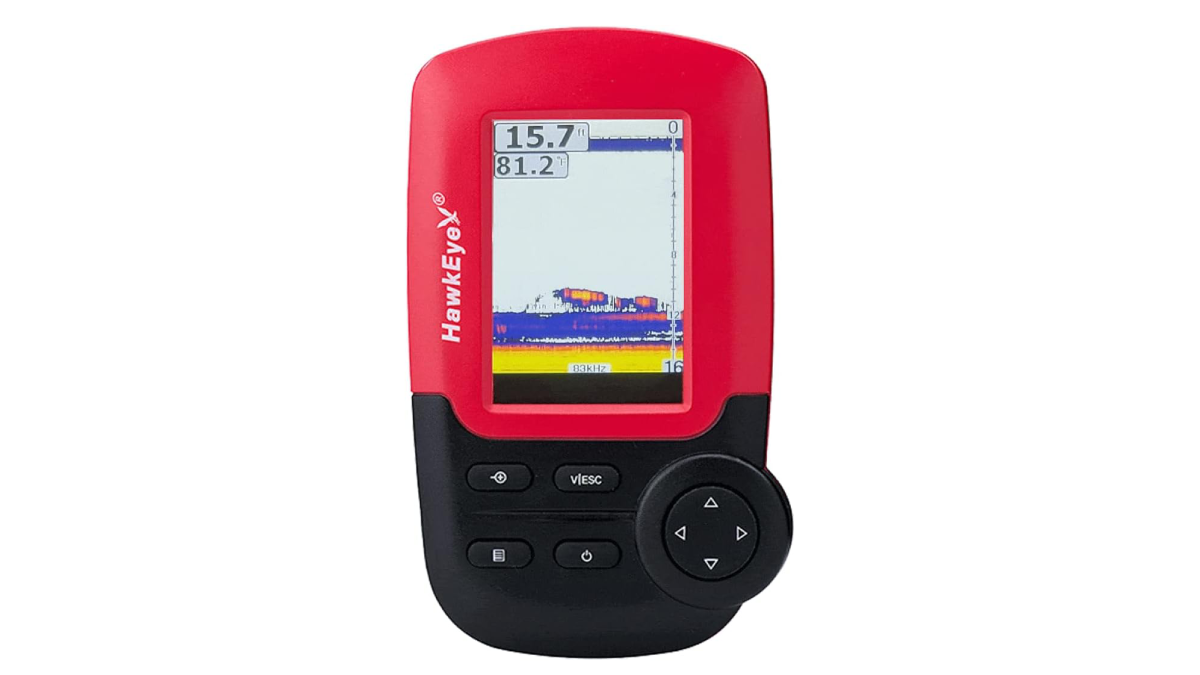
Pros
Uses standard AAA batteries
Color screen
Dual-beam sonar
Cons
No GPS
Small screen
When choosing the right fish finder for your kayak, this one is a great choice. The HawkEye FishTrax 1C-K Paddlesport’s glare-resistant color display is the smallest and lightest in my review. The display and transducer arm mount to a base that connects to any standard gear track, making it quick and easy to install and remove in seconds. The universal transducer works well on a boat or kayak, and it floats for ice fishing.
In addition to the kayak kit, HawkEye offers an ice fishing bag and other accessories to make the FishTrax 1c-K even more versatile. Or, use your own accessories; the universal TraxNut connects to any ¼ – 20 threaded mount. Best of all, the unit runs for 30 hours on four AAA batteries, so there’s no need for a bulky external battery and wires. It’s easily one of the best fish finders for kayaks out there.
Specs
Weight: 3 pounds
Dimensions: 10” x 9” x 5”
Screen Size: 2 inches
Best for Bank Fishing: Lucky Kayak Handheld Fish Finder
Best for Bank Fishing
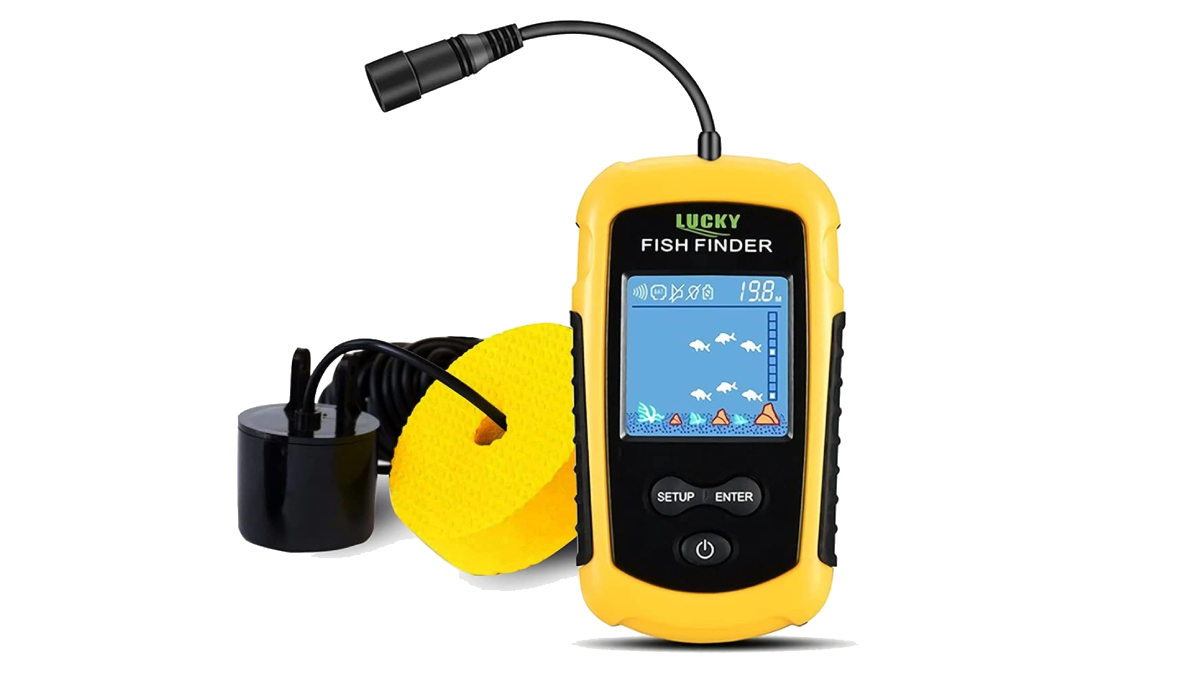
Pros
Great price point
Simple to use
Versatile
Cons
Not waterproof
Using a fish finder from shore presents a special challenge. However, the Lucky kayak handheld utilizes a castable transducer that feeds back underwater data from over 300 feet. Unlike other castable transducers, this finder has a dedicated display of its own. Many modern fish finders are quite complex. This one is a great option for anyone who wants something that’s simple and to the point. All the basics for depth and fish location are here. The display shows three different types of fish icon to indicate the size of each target.
The finder also reads the water temperature, helping anglers make more informed lure decisions on the fly. However, it has the capability to show the bottom and structure too. This finder also excels for ice fishing and smaller craft such as kayaks. The only real knock against it is that it’s often falsely advertised as waterproof. Just treat it like any other form of electronics near the water’s edge and it’s a unit that will last a while. I like it for a younger, first-time angler who’s still learning the ropes.
Specs
Weight: 11.6 ounces
Dimensions: 6.46″ x 4.65″ x 4.02″
Screen Size: 4 inches
Best for Ice Fishing: Humminbird Ice Helix 9 Mega Live
Best for Ice Fishing
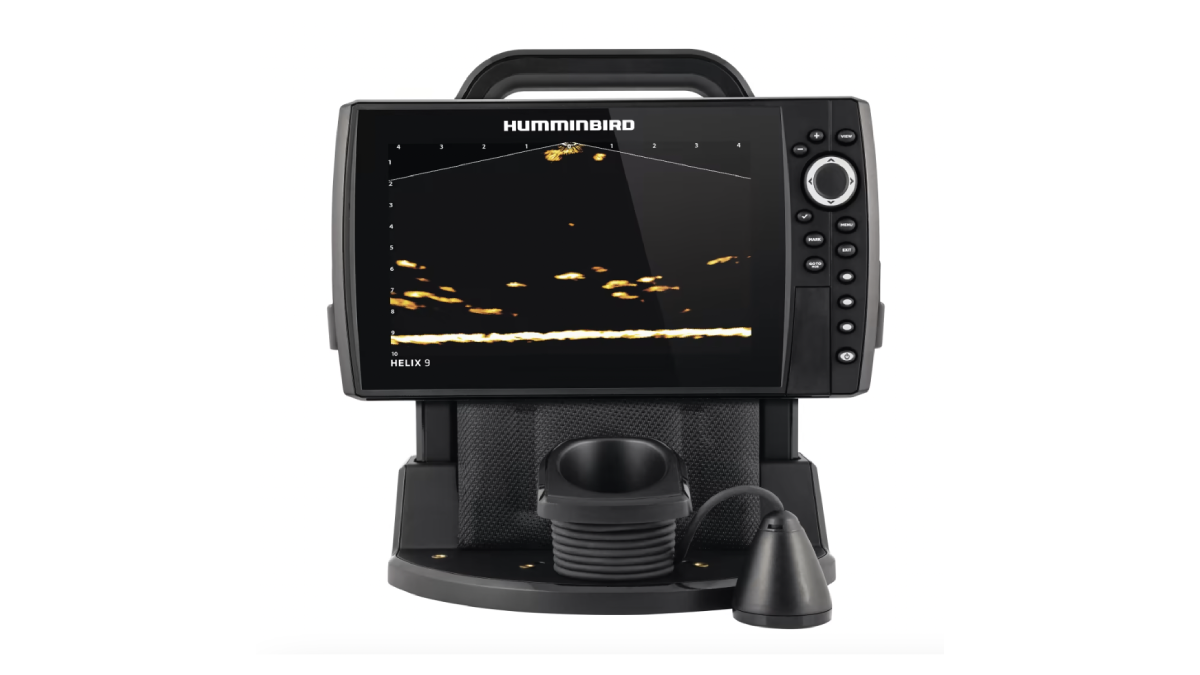
Pros
Live view sonar
Premium charts
Lithium-ion battery included
Cons
Expensive
Protective case not included
Mainstays of the fish finder market, Humminbird is the industry standard. They created the ultimate portable fish finder and GPS with the Ice Helix 9 MEGA. The fish finder features Humminbird’s latest MEGA Live sonar producing the clearest, most life-like images of fish and structure up to 100 feet around the angler. For the full spectrum of sonar options, the Helix 9 also includes CHIRP, down scan, and side scan imaging.
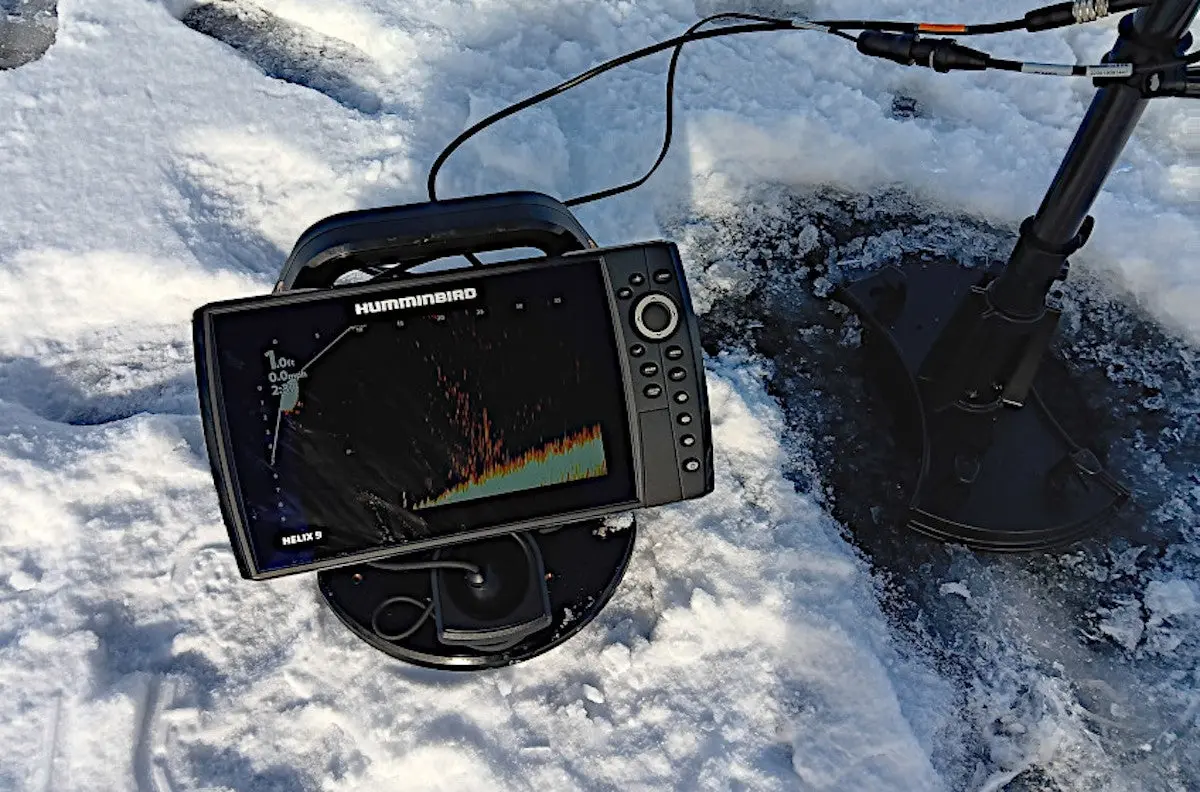
| I’ve had a lot of success using the Helix 9 for ice fishing. (Photo/Travis Smola) |
On the navigation side, the Helix 9 includes Humminbird’s top-of-the-line LakeMaster and CoastMaster charts with depth contours to one foot and up-to-date navigation data.
A great fish finder for ice fishing, the Helix 9 has a huge nine-inch screen that’s bright and clear whether you are fishing on the blinding ice or in the glaring sun. Controls are intuitive and easy to operate even with fingers that are frozen or covered in fish slime. The Humminbird fish finder comes with ice fishing accessories, or you can add a base for the control head and bracket for the transducer to take the Helix 9 onto your boat or kayak.
Specs
Screen Size: 9 inches
Power Draw: 2.4 amps
Maximum Depth: 1,200 feet
Best Budget: Deeper Pro+
Best Budget

Pros
Fits in a pocket
Connects with smartphone
Least expensive
Cons
Basic GPS
Get a powerful sonar and basic GPS on your smartphone. Connect the Deeper Pro Plus to its iOS or Android app, tie the transducer ball to your fishing line, then cast it up to 300 feet away and retrieve slowly. The unit’s dual-signal transducer transmits images of the fish and bottom along with depth and water temperature straight to your smartphone screen.
Turn on the mapping feature and the Deeper Pro Plus will create custom maps of the bottom. The GPS plotter also offers basic navigation and waypoint recording. My favorite feature is the digital fishing log and online social network to record our best catches and share with friends.
Specs
Screen Size: 3.53 inches
Dimensions: 5.9” x 5.32” x 2.95”
Maximum Depth: 260 feet
How We Tested Portable Fish Finders
The best portable fish finders, well, need to be portable. The idea of being mobile while still performing at a high level was at the core of my testing. A reliable portable fish finder needs to be able to take abuse in all different environments and fishing styles without blinking an eye. For each category, I compared apples to apples, looking at the most popular models with similar features and price tags to find the best portable fish finders at the best value. Then, I took to the kayak, boat, and even onto the ice to test how the parts came together for easy operation and effective performance.
Size: How well does the display, transducer, and accessories fit into a portable carry case?
Performance: Does the fish finder give accurate readings of structure, water temperature, and depth?
Durability: How well does the fish finder take abuse? Can it withstand being transported from boat to kayak to the ice shack?
Setup: How difficult is it to setup and transport?
Value: Does the quality of the fish finder match the price tag?
Portable Fish Finder Buying Guide
There are many choices for the best portable fish finders and great options at every level. To meet the need of anglers fishing from kayak, boat, shore, and on ice, manufacturers are packing the latest portable fish finders with the most modern features like live view sonar and premium charts. And they’ve perfected keeping the control unit, battery, transducer, and other accessories compact enough to fit in a take-anywhere carry case.
To pick the best portable fish finder, consider how you will use the sonar and navigation system. For shore and kayak anglers, a basic system with sonar and GPS plotter is easy to install and transport. However, anglers looking to carry their portable fish finder from boat to ice to kayak will appreciate the advanced live and scanning sonar and premium charts. Here are three things to think about when choosing the best portable fish finder.
2D/CHIRP Sonar
Most fish finders today offer a bevy of different views for displaying what’s beneath the surface. The most traditional is a simple 2D view in which fish show up as simple arches. This type of sonar can also help anglers find bottom structure and even identify the bottom type based on the color displayed. Most units use 2D CHIRP sonar these days. It’s simply an updated version that provides a much better picture with less chance to misinterpret a fish.
Side and Down Imaging
These imaging types are extremely popular today simply because they show an incredibly detailed picture of the water column. Down imaging utilizes a single vertical cone beneath the transducer to show a detailed picture below. This type of imaging can show bottom structure in incredible detail. There’s no more wondering if it’s a tree or a weed patch. It’s obvious with this type of imaging.
Side imaging is exactly that. Instead of a single sonar cone, there are two on either side of the boat. The great thing about side imaging is that it paints a very detailed picture of everything on the bottom. It’s very easy to differentiate muddy areas from hard pack using this sonar. Likewise, it’s easy to spot and identify structure. In my local lake, I was very surprised to see the crystal clear outlines of old rowboats and canoes long sunken on the bottom.
Because this type of imaging covers up to 100 feet on either side of the boat, it makes it easy to search a large area for promising spots fast. Many units like the Helix 9 also allow anglers to mark objects, making it easy to return later.
Live Scope/Live Imaging
Traditional sonar types show a static image. The inherent flaw here is that the angler is essentially looking at a picture of the past. By the time an angler sees it, the fish may have swum away. Live transducers are different because they are constantly feeding real-time images of everything going on beneath the surface. What’s more, anglers can literally manipulate a fish into biting in real time because it’s easy to follow the lure on screen. No wonder many tournament anglers have taken to calling it “video game fishing.”
The downside is that live imaging is that the tech is extremely expensive. Live transducers alone typically start at $1,000. Add in a unit capable of displaying live and it’s not uncommon to spend at least $3,000. The price will probably go down eventually. But for now, because live sonar is new, it’s a big pill to swallow.
Live sonar also shows a much narrower view of the water column than other types. However, used properly, there isn’t a much more exciting way to fish than a real-time system.
GPS and Charts
Many anglers overlook the importance of underwater charts on their devices. However, these are vital tools for professionals. Mainly because it makes it easy to spot promising points, drop-offs, and underwater humps that might be holding fish. Simply navigate to them and hit with the sonar to see what might be hiding there.
The usefulness goes beyond just spotting locations though. The best units allow anglers to mark places and structure that are holding fish. That means no more guesswork on re-finding that brush pile or sunken tree that’s holding big fish.
The only downside is that many companies sell these types of charts separately on an SD card that’s inserted into the unit. The cards can easily run $80 – $300 depending on how many states and bodies of water are included. It’s worth factoring in for those looking to save money on a fish finder.
Portability
Portable fish finders are more than just a fish finder in a bag. They need to be versatile, allowing anglers to transport them easily and use them in any situation. The carry case or shuttle houses will protect the control head with room for accessories and battery.
To go from boat to kayak to the ice, the best portable fish finder will have attachments that make it easy to install the display and transducer. Fortunately, there’s a plethora of aftermarket products out there that can help adapt just about any finder to any boat or kayak.
FAQs
Q: How does a portable fish finder work?
Portable fish finders utilize a transducer to send out ultrasonic sound waves. These waves then reflect images back of what’s under the surface to the finder. The biggest difference between a portable finder and a standard one is the power source. Anglers will need an extra battery to power the setup while on the ice, in a kayak, or other small craft. Depending on the model, it may require a little wiring knowledge to power properly.
Q: How much do portable fish finders cost?
Portable fish finders range in price from just over a hundred dollars to thousands of dollars. Most of the price is in the control unit. A large nine-inch touch screen display costs more than a two-inch screen. Although an advanced imaging transducer can also increase the price. Portable fish finders come with a carry case or shuttle and other accessories, which can add to the price as well. Manufacturers often sell the case, display, and transducers separately. There are pre-packaged bundles that are extremely expensive. However, if you add up the costs, there’s often some significant savings with these packages.
Q: Can you use a fish finder without a boat?
Yes. The best portable fish finders will be just as useful from a boat or kayak, but anglers can certainly use a fish finder without a boat. If you are fishing from shore or on the ice, you still have options for electronics. Most portable fish finders can be turned into an ice fishing fish finder by adding a special broadband transducer to produce real-time images of the fish and structure below the water. To use a fish finder from shore, choose a castable transducer and smartphone application (like the Deeper Pro Plus). Then cast the transducer away from shore and it will transmit images of fish and structure to your smartphone.
Q: Do I need a GPS on a portable fish finder?
The best portable fish finders double as a navigation tool. A fish finder with GPS helps you find the most productive fishing locations and safely navigate on the water. But all GPS and fish finder combos are not the same. The best navigation systems offer charts detain underwater elevations down to one-foot increments. The least expensive option is a GPS plotter. A plotter doesn’t display maps but saves tracks and waypoints to mark fishing hot spots and important locations. Some anglers fishing from shore, a small boat, or on a kayak may not need a fish finder and GPS combo. While you don’t need a GPS with a portable fish finder, today’s technology makes it easy and affordable to combine sonar with navigation.
Q: Can I use my phone as a fish finder?
Yes, but using a phone as a fish finder requires buying a compatible transducer such as the Deeper Pro Plus with an app that can read it. It’s a good idea to buy a power bank to go with it because these apps can be battery intensive. It’s the best way to keep it going through a long day of fishing.
Q: What is the best portable fish finder?
The Lowrance Hook2 4X is a perfect combination of affordability and portability. It’s the ideal unit for the angler who wants an ice unit that can easily transition to use with a kayak or other small boat. In a world where fishing electronics keep getting more expensive, there’s a ton of value with the all-season bundle for under $300.
Why Trust Us
For more than 125 years, Field & Stream has been providing readers with honest and authentic coverage of outdoor gear. Our writers and editors eat, sleep, and breathe the outdoors, and that passion comes through in our product reviews. You can count on F&S to keep you up to date on the best new gear. And when we write about a product—whether it’s a bass lure or a backpack—we cover the good and the bad, so you know exactly what to expect before you decide to make a purchase.
![Field & Stream [dev]](https://images.ctfassets.net/fbkgl98xrr9f/1GnddAVcyeew2hQvUmrFpw/e4ca91baa53a1ecd66f76b1ef472932b/mob-logo.svg)




